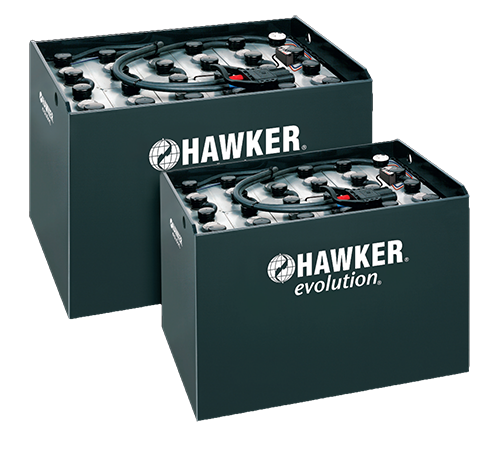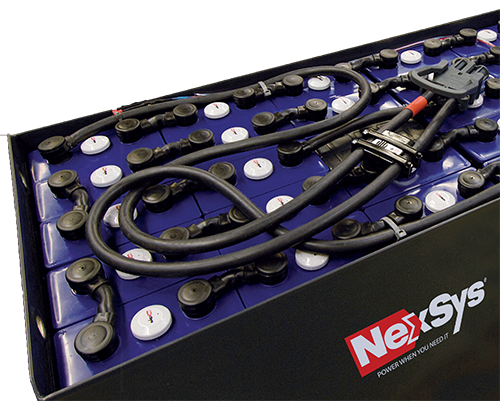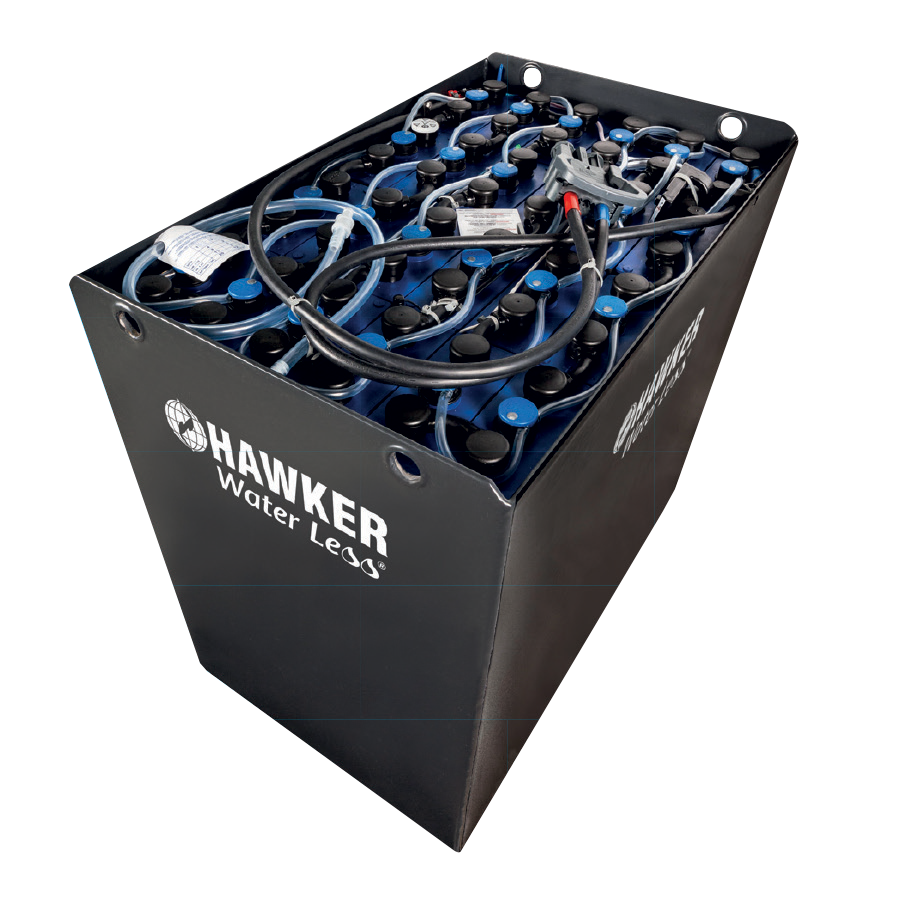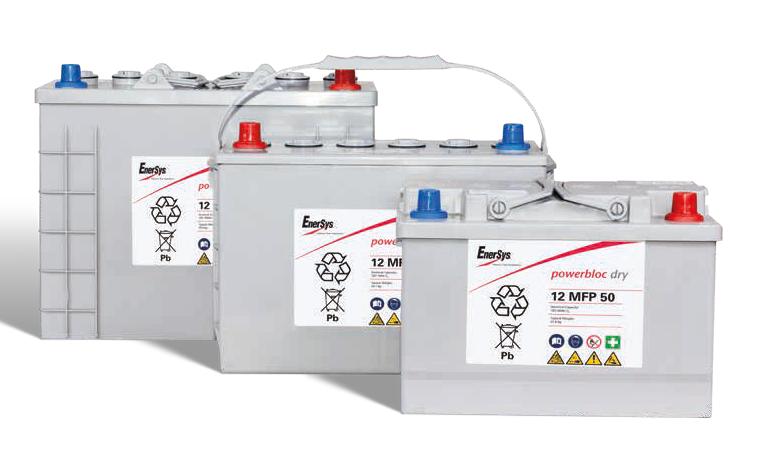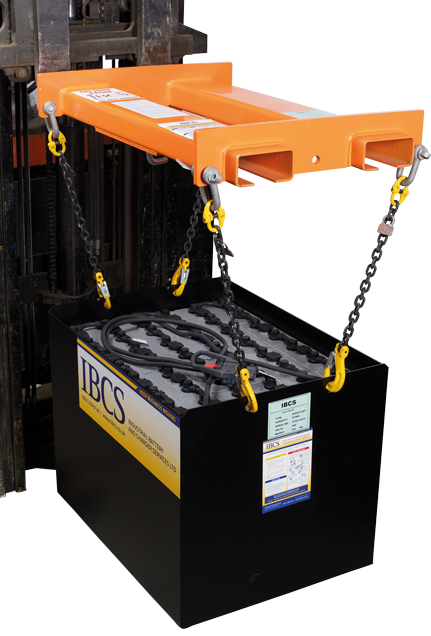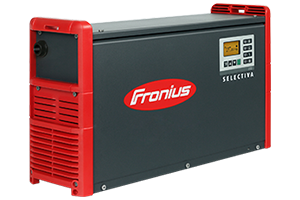WHAT ACTUALLY HAPPENS DURING THE CHARGE CYCLE OF THE FORKLIFT BATTERY OR TRACTION BATTERY?
There is a strong misconception that an oversized charger will simply recharge the battery properly in a shorter time period. A battery is designed to absorb a charge at a controlled rate. If it is charged at a faster rate, the energy that it cannot absorb is converted into heat. Cell temperatures rise, and the battery, in effect, “cooks in it’s own juices”.
If the charger is not large enough to reverse the electro chemical reaction in the battery within the allotted time, some of the acid will remain in the plates. The battery will not perform in accordance with it’s ampere-hour rating capacity. More serious is the permanent loss of capacity resulting from repeatedly leaving acid in the plates. The results you would experience would be an 840 ampere-hour battery performing like a 400 to 500 ampere-hour battery if it is continually undercharged (50% or more loss of shift time).
WHAT ARE THE FUNDAMENTAL PRINCIPLES OF A TRACTION BATTERY OR FORKLIFT BATTERY?
In its fully charged state, the active material of the positive plate is lead dioxide, and that of the negative plate, porous or spongy lead.
A lead acid battery is a “secondary battery” in that it can be discharged and recharged a number of times before reaching the end of its life. This is because the chemical reaction which takes place in a lead acid battery is reversible. (Primary batteries, such as zinc/manganese dioxide batteries widely used in torches, radios etc. cannot be recharged and have to be discarded once discharged).
When a cell is discharged, the sulphuric acid reacts with the active materials on the positive and negative plates. From the reaction on the spongy lead of the negative plate, electrons are liberated, whilst electrons are absorbed by the reaction on the lead dioxide on the positive plate. Consequently a current flows between the two plates.
Furthermore, in both reactions the active materials are gradually converted to lead sulphate, whilst the sulphuric acid is converted to water. Sulphuric acid being heavier than water, the specific gravity (S.G.) of the electrolyte therefore drops during discharge, as the acid is being “used up”. In the process, the volume of the electrolyte decreases somewhat, with a resultant drop in the electrolyte level.
When recharged, the sulphate ions in the active materials recombine with the excess water in the electrolyte and convert back to sulphuric acid. As a result, the S.G. increases back to original top of charge levels. Simultaneously the lead sulphate converts back to lead dioxide on the positive, and spongy lead on the negative plate respectively. Again, the volume of electrolyte increases, and the electrolyte level rises, as the cell is charged.
As the cell approaches its fully charged condition, the chemical conversion can no longer absorb all of the charging current. The surplus current results in the liberation of hydrogen from the negative plate, and oxygen from the positive plate. This process is commonly known as gassing and is the primary reason why these cells need regular topping up with water. Subject to the condition and age of the cell, gassing normally starts at approximately 2.35 volts.
Gassing helps to agitate the electrolyte in the cell, thereby mixing the heavy sulphuric acid with the water in the electrolyte. Specific gravity readings during charge should therefore always be taken at the end of charge to ensure proper readings. Illustration 1: While the electrolyte S.G. drops linearly with discharge, it increases meaningfully during recharge only once gassing voltage is reached.
Because of linear change of electrolyte S.G. during discharge, S.G. is preferred over voltage as a measure of state of discharge. Temperature affects S.G. and S.G. readings taken should be adjusted to 25°C.
The open circuit voltage of a fully charged cell is approximately 2.13 volts. When on charge, the voltage will rise from approximately 2.15 volt to a final value approaching 2.70 volts. The latter voltage is reached when the charge current has dropped to approximately 3% of the cell capacity. This is called the equalising current and serves to ensure all cells in the battery have reached top of charge.
Cell capacity is dependent upon the discharge rate. Motive power batteries are rated at the 5 hour discharge rate. This means that a 500 ampere hour (Ah) battery can be discharged for 5 hours at 100 ampere to a minimum voltage of 1.7 volt per cell. Beyond this point, known as the knee of the voltage curve, the cell voltage will drop off rapidly. Refer to illustration 2. Higher or lower rates of discharge have lower and higher voltage cut off points respectively.
Battery life is dependent on many factors, of which temperature, quality of topping up water, proper charging and regular maintenance are of major importance.
High cell temperatures reduce life dramatically. Unnecessarily high charge rates and high ambient temperatures are prime reasons for high cell temperatures.
Poor quality topping up water containing harmful substances will chemically reduce the ability of the cell to deliver to its rated capacity.
Incomplete charging will lead to irreversible sulphation of cells, and out of step batteries. Overcharging will result in damage to the plates and high cell temperatures.
Regular and proper maintenance is important to identify and correct such problems before permanent harm is done to a battery. The following chapters serve as a guide to help users perform this maintenance.
WHAT DO I NEED TO KNOW ABOUT CHARGING A FORKLIFT BATTERY OR TRACTION BATTERY?
In general, a battery may be charged at any rate in amperes that will not produce excessive gassing or result in electrolyte temperatures above 45°C. A discharged battery can accept high rates of charge initially but, as the gassing stage is approached (2.35 volts per cell), the current must be reduced to avoid excessive gassing and high temperatures which can permanently damage the plates and separators.
A battery should always receive the ‘correct’ amount of charge – sufficient to fully charge it and/or maintain it in that condition, but no more. In other words, undercharging or overcharging should be avoided to the extent that it is practical under conditions of usage. An insufficient charge, even to the smallest degree but continuously, will cause gradual sulphation of the plates, with eventual loss of capacity and a reduction of battery life.
Excessive charging will tend to ‘form up’, or corrode, the positive spines into lead dioxide, weakening them physically and increasing their electrical resistance. If overcharging is at comparatively high rates, gassing will also be excessive and this tends to “wash” the active material from the plates. All of these factors reduce the capacity and shorten the life of the battery.
With any type of battery operation there are reasonably simple checks to determine whether or not the amount of charge is correct. If the proper amount of charging is being given, the specific gravity will reach its fully charged value at the end of recharge and will remain at that value. In addition, the amount of water required by the cells will be minimal.
If the specific gravity does not reach full charge value and/or tends to show a continuing decline it is evident that the battery is not receiving sufficient charge.
On the other hand, if the specific gravity reaches or remains at full charge level and an excessive amount of water is required, the battery is receiving an excessive charge and the rate should be reduced.
To keep the battery in good condition it is necessary to use a charging regime that takes into consideration the operational function of the battery. To provide the correct charge regime the current and voltage of the charger must be correctly adjusted and the duration of the different charging stages carefully monitored. Volt and ammeters should be calibrated at regular (six-to-twelve monthly) intervals.
Charging regimes must comply with the following requirements:
- The duration must be acceptable for the duty cycle
- Ampere hour and Watt hour efficiencies must attain maximum values to ensure total transformation of energy
WHAT DO I NEED TO KNOW ABOUT THE SPECIFIC GRAVITY MEASUREMENT OF A FORKLIFT OR TRACTION BATTERY?
Determing the state of charge of the battery
Dilution of the electrolyte during discharge and re-concentration during charge is a useful guide to the state of charge of a lead acid cell. The less acid there is in the electrolyte, the less dense it is, and the lower its specific gravity (S.G.). One cubic centimetre of water has a mass of 1 gram. In other words, its density is 1 gram per cm 3 at 4°C . Specific gravity is the ratio of the density of the substance measured to the density of water. Density of water at 4°C = 1.000 g/cm 3 but only decreases slowly as temperature increases. The specific gravity of water is therefore usually expressed as 1.000.
Specific gravity could also be expressed as the mass of the liquid divided by the mass of an equal volume of water. Specific gravities are usually measured with a hydrometer. This works on the principle that a float will sink further into a liquid of low specific gravity than of high specific gravity because the latter is denser and provides greater support.
Using The Hydrometer
From one of the cells, draw acid into the barrel until the hydrometer float moves freely. Now read the specific gravity at the point where the scale emerges from the acid. Afterwards, make sure the acid is returned to the cell from which it was drawn, or the specific gravity and acid level of both cells will be altered.
When taking a reading:
- Make sure that there are no air bubbles under the float
- Bring your eye level with the acid surface in the barrel of the hydrometer
- Ensure that the hydrometer is in a vertical position
- If necessary, shake the hydrometer gently to enable the float to move freely
- If the ambient temperature differs from the battery temperature, draw in electrolyte to warm the hydrometer first
- Read off against the lower meniscus
- The change in specific gravity of the acid is directly proportional to the ampere hours taken out of the cell on discharge.
Where extreme accuracy is required, a reading should be taken after a stabilisation period of several hours with the battery on open circuit. The minimum recommended specific gravity is 1.160. Select a different pilot cell each month to serve as a useful, general indicator for the condition of the battery during charge and discharge.
Note:
- The specific gravity of a cell will decrease with any increase in temperature
- Always record the electrolyte temperature when specific gravity readings are taken
- Cells should not as a rule be discharged more than 80% of their nominal capacity
Temperature Correction
All specific gravities quoted relate to temperature at 25°C and have to be corrected if read at other electrolyte temperatures. Specific gravities decrease as the temperature increases. To provide a standard, the specific gravity can be corrected to 25°C.
Take the temperature of the electrolyte and add 7 points (0.007) to the specific gravity reading for every ten degrees above 25°C
Or subtract 7 points (0.007) from the specific gravity reading for every ten degrees below 25°C
For example:
A reading of 1.255 at 35°C corrected to 25°C gives 1.255 + 0.007 = 1.262
Or a reading of 1.275 at 15°C corrected to 25°C gives 1.275 – 0.007 = 1.268
Specific Gravity When Fully Charged
With the electrolyte level correct, the fully charged specific gravity should be in the range of 1.290 -1.300 at 25°C exept for new cells. For new cells the fully charged specific gravity will be 1.260 – 1.270. After a few weeks of service the specific gravity will rise and will typically stabilise between 1.290 -1.300.
WHAT DOES A TRACTION BATTERY DO?
- Powers the motor that drives an electric vehicle such as forklift truck
- Powers accessories like headlights on an electric vehicle
- Provides power for a specific purpose on an electric vehicle such as the lift on an electric forklift truck
WHAT HAPPENS IF THE BATTERY IS OVER-FILLED WITH WATER?
WHAT HAPPENS WHEN THE WATER LEVEL IS TOO LOW?
WHERE DOES THE WATER IN AN INDUSTRIAL FORKLIFT TRUCK BATTERY GO?
Water (H20) is transformed into gasses during the charge cycle. Hydrogen bubbles are produced at the negative plates and oxygen bubbles at the positive plates. The Hydrogen and Oxygen bubbles are released into the air, and gassing (which is perfectly normal and indeed a requirement) occurs in the range of 2.35 to 2.38 volts per cell (this value changes as temperature changes).
WHY SHOULD A BATTERY NOT BE DISCHARGED MORE THAN 80% OF ITS CAPACITY?
If the battery is grossly over discharged the temperature will rise dramatically in the latter stages. The battery should be allowed to cool before recharge.
HOW DO AUTOMATIC TIME RELAYS WORK?
Most of these devices have L.E.D. indication for charge conditions showing first rate, second rate, equalizing rate and charge complete.
HOW BIG IS A TRACTION BATTERY'S CAPACITY?
A traction battery is considered to be at the end of its useful life when its capacity decreases below 80% of its rating. However, it can sometimes be transferred to a smaller job to provide additional life and service.
As a motive power battery usually discharges every day in the course of its regular performance, it is seldom necessary to conduct a formal test of its capacity. Most users do not have the facilities to do this conveniently or accurately. If any such testing is desired, consult the Dart Traction service engineer.
WHAT ARE THE FEATURES OF THE WATER USED FOR TOPPING UP TRACTION BATTERIES?
- It shall be clear, colourless and odourless
- The pH shall be between 5 and 7
- Impurities shall not exceed these limits
- It shall, wherever possible, be stored in a glass or plastic container
- Conductivity shall be less than 30 µS/cm
| Impurities | Milligrams per litre |
| Dissolved solids | 25 |
| Arsenic (AS) | 1 |
| Chloride (Cu) | 5 |
| Copper (Cm) | 0.1 |
| Iron (Fe) | 0.2 |
| Manganese (Mn) | 0.1 |
| Nitrogen (as NH4) | 5 |
| Nitrogen (as NO3) | 5 |
| Heavy metals (as Pb) | 5 |
| KMnO4 reducing substances * | 10 |
WHAT IS A CHARGE CYCLE OF A SULPHATED BATTERY?
The elevated voltage in the second rate will allow the current to climb as the sulphation is broken down and repeated charges could ultimately recover the battery.
WHAT IS CONSTANT CURRENT CHARGING?
Battery Ah
5 = Amperes
As with the taper charger the charger control senses 2.4 volts and activates the ‘second rate’ for a period of 3 to 4 hours, at a constant current rate of:
Battery Ah
15 = Amperes
At the end of this period the unit usually switches automatically to ‘equalize rate’ and continues to charge at:
Battery Ah
30 = Amperes
for 3 or 4 hours before automatically switching off.
WHAT ARE THE BASIC PRINCIPLES OF DC BATTERY CHARGERS?
Each of these three types is available as either eight-hour or twelve-hour chargers, depending on the user’s requirements.
WHEN DOES A TRACTION BATTERY CHARGING PROCESS TERMINATE?
WHAT IS AN EQUALIZING CHARGE AND WHEN SHOULD I USE IT?
If the variation is allowed to continue, the differences may be further accentuated and the effective working life of the battery may be reduced. To avoid this, an equalizing charge is recommended. This is an extended charge which should be given at least once a week. Most chargers have an automatic switch which selects the special rate for an equalizing charge. Such a charge is complete when the voltage and specific gravities of the cells have remained constant over three successive hourly readings.
WHAT ARE THE IMPLICATIONS OF HIGH TEMPERATURES ON BATTERY OPERATION AND HOW CAN I AVOID THEM?
- Avoiding over-discharge
- Charging in a cool location
- Supplying ample ventilation during charge by opening the battery compartment and circulating air by fans if necessary
Note: For every 10 °C rise in average battery temperature, the service life of lead acid batteries is reduced by approximately 50%.
HOW DOES A MODIFIED CONSTANT CURRENT/TAPER WORK?
Battery Ah / 5 = Amperes until the battery reaches a voltage of 2.40 volts per cell. After this stage the charger switches to a second rate taper charge mode, with the battery voltage rising to approximately 2.44 volts per cell, allowing the current to taper down. This taper rate depends on battery discharge and age. The taper rate is fixed by the charger timer for a 5 hour period after which the control unit switches to the equalizing mode at 30 Amperes. This rate will continue until the overall charging time has reached 12 hours. On a new battery under equalizing charge the voltage will rise to approximately 2.6 to 2.7 volts per cell.
WHAT ARE THE IMPLICATIONS OF OVERCHARGING?
Overcharging due to excessively high charging rates or charging for too long a period produces excess gassing, high temperatures and corrosion of the positive spine. These all result in shedding of active materials and greater water loss.
WHEN IS A BATTERY OVER-DISCHARGED AND WHAT CAN AN OVER-DISCHARGING CAUSE?
WHAT ARE THE IMPLICATIONS OF UNDERCHARGING?
WHAT ARE THE BEST STORAGE CONDITIONS FOR TRACTION BATTERIES?
WHAT ARE TYPER CHARGERS?
The charge starts at the ‘first rate’ for an undefined period until 2.35 volts per cell is reached. For this period the starting current should be:
Battery Ampere hours (Ah)
7.2 = Amperes
The charger control senses the cell voltage and at 2.35 volts per cell activates the ‘second rate’ usually for a period of 3-4 hours after which the unit switches off. Battery manufacturers normally specify the maximum charge current at 2.5 volts per cell as follows:
Battery Ah
12 = Amperes
Many taper chargers have an automatic equalize facility, but sometimes the equalize charge is set manually by a switch.
Equalize charging current should be:
Battery Ah
30 = Amperes
It usually takes about 12 hours for a taper charger to charge a fully discharged battery.
WARNING!
The taper charger is highly susceptible to mains voltage fluctuation. A 10% increase in voltage input can result in up to 45% increase in output current. Where the voltage supply is not stable the taper charger is not recommended.#

